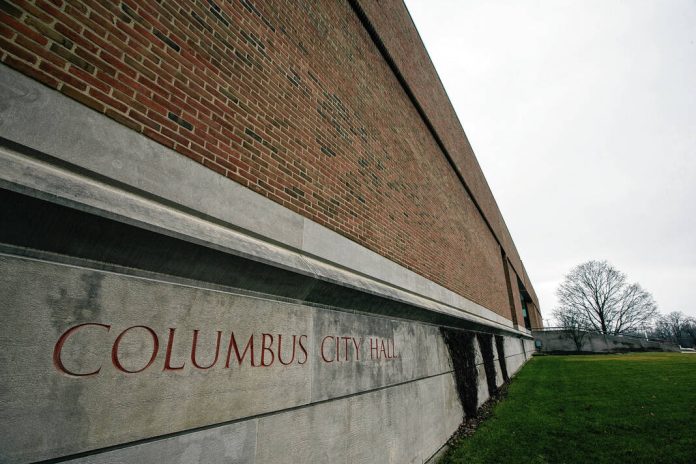Columbus City Council members have approved a resolution 7-0 to accept a proposal submitted by the United Way of Bartholomew County to address homelessness in Columbus. Council members Jerone Wood and Grace Kestler were not present at the meeting.
The city plans to use $133,000 of American Rescue Plan (ARP) money, already budgeted for 2024, to fund the homelessness initiative, according to city Executive Director of Administration Eric Frey.
“The resolution basically acknowledges the presentation we received from United Way and their commitment to make this move forward, the acknowledgement that we will be looking at utilizing the American Rescue Plan funding and that council desires to allow for the executive administration to execute any agreements, utilizing those ARP dollars to move that initiative forward,” Frey said.
United Way’s proposal lays out four strategies, accompanied by various activities to support them.
The four strategies in United Way’s proposal include:
- Bring the community together for a shared understanding
- Implement modifications to the social-service delivery system to better serve those who are homeless
- Provide targeted recommendations on homeless related services
- Robust communication with key stakeholders and general public
The plan states $46,500 is budgeted to go towards addressing the first strategy, which includes two public workshops, interviewing key stakeholders and a comprehensive outline of the system as it currently is.
The largest portion, $79,300, is earmarked for the second strategy, which calls for a way to quickly connect the homeless to resources, a “Homeless Response Team,” and a “Street Social Worker pilot program.”
There is $27,000 to help establish a “coordinated entry system” to help connect those experiencing homelessness to needed services, more specifically through the development of a mobile app “that could be used by anyone in the community who encounters a homeless person and would like to help them connect to resources,” the proposal states.
An additional $30,000 will fund a pilot program where a social worker would go out to “find, help, address folks who are homeless and (design) resources that help for that particular person, then provide targeted recommendations on investments designed to reduce homelessness in our community,” Stewart said when introducing the proposal on April 2.
The homeless response team will made up of service providers who can support people searching for stable housing, per the United Way proposal.
Strategies three and four, with $3,000 and $4,500 budgeted for each respectively, refer to a list of targeted recommendations United Way will produce to address the issue and the communication of those to the public.
The strategies that United Way proposed are “rooted in best practices” that other communities in the United States used to make progress in reducing instances of homelessness. Stewart previously mentioned Bakersfield, California, Rockford, Illinois, Milwaukee, Wisconsin as examples.
During public comment, Tami Watson said she recently realized there were several homeless tents in the woods across from Clifty Creek Elementary School and south of Smith Elementary, near where she lives. Her son, a certified drone operator, was showing his young son his drone when he “inadvertently” located the tents.
“I posted this publicly on Facebook, I did a Facebook post the other day speaking on this,” Watson told the council. “And right after I posted this, I get a threat to my inbox on Facebook from one of the homeless individuals.”
Watson, a former state trooper, reported the threat to the Bartholomew County Sheriff’s Office.
“Now am I worried about that individual? I don’t fear that individual, but parents do,” Watson said. “And I think when we look at the situation, solutions that we have for the homeless in our community, I know that it’s a totally fine line, because not everyone wants to be helped.”
Watson added that “we cannot lump our homeless into one group” and advocated for a forum where service providers could explain what they offer and what their polices are. She also implored the city to do more to communicate with the public on issues like this through their social media.
Community-member Jacob Jost, who often works with the homeless, said he hadn’t yet seen United Way’s proposal, but wondered if there would be a place for the homeless to stay temporarily if they have been forced to relocate. For instance, Jost mentioned that even if someone is staying at Brighter Days, they could be made to leave if they stay more than 180 days.
“A lot of these people who have journeyed their way into Columbus that don’t have an address or something or haven’t found the Engagement Center to get that, they’re out here and they’re not able to find temporary shelter until Brighter Days is able to help them or until they find a place to go,” Jost said.
Stewart said in response that local organizations that assist the homeless sometimes have conflicting policies, which he said their proposal wishes to address.
“There are a number of different organizations within the community that kind of engage in assistance to help people who are homeless,” Stewart said. “And often, the policies they implemented within their organizations conflict with some other policy, and a part of the proposal is to evaluate across the community, the multiple policies that institutions and organizations have to try to streamline that as far as getting more immediate assistance. I’m happy to work with Jacob to see what we can start out with, with the existing resources.”
Stewart added they are planning to “have a really large public input session fairly soon.”
“The homeless issue, as we all know, is a complicated, messy issue. It’s not something that we’re going to solve immediately. We’re not going to solve it from one forum,” Council President Frank Miller said, later mentioning he hopes the county gets on board as well.
Councilman Kent Anderson thanked the public for their comments and reiterated some of what Miller had said.
“You know, this is a part-time job for us. Trust me, we are one of many entities in the city. And so the city council doesn’t solve issues, the city as a community solves issues. And that’s why we’ve gone to United Way, they’re there full-time, built to bring everybody together to collaborate.”
To view a pdf copy of the initiative, click on the link:





